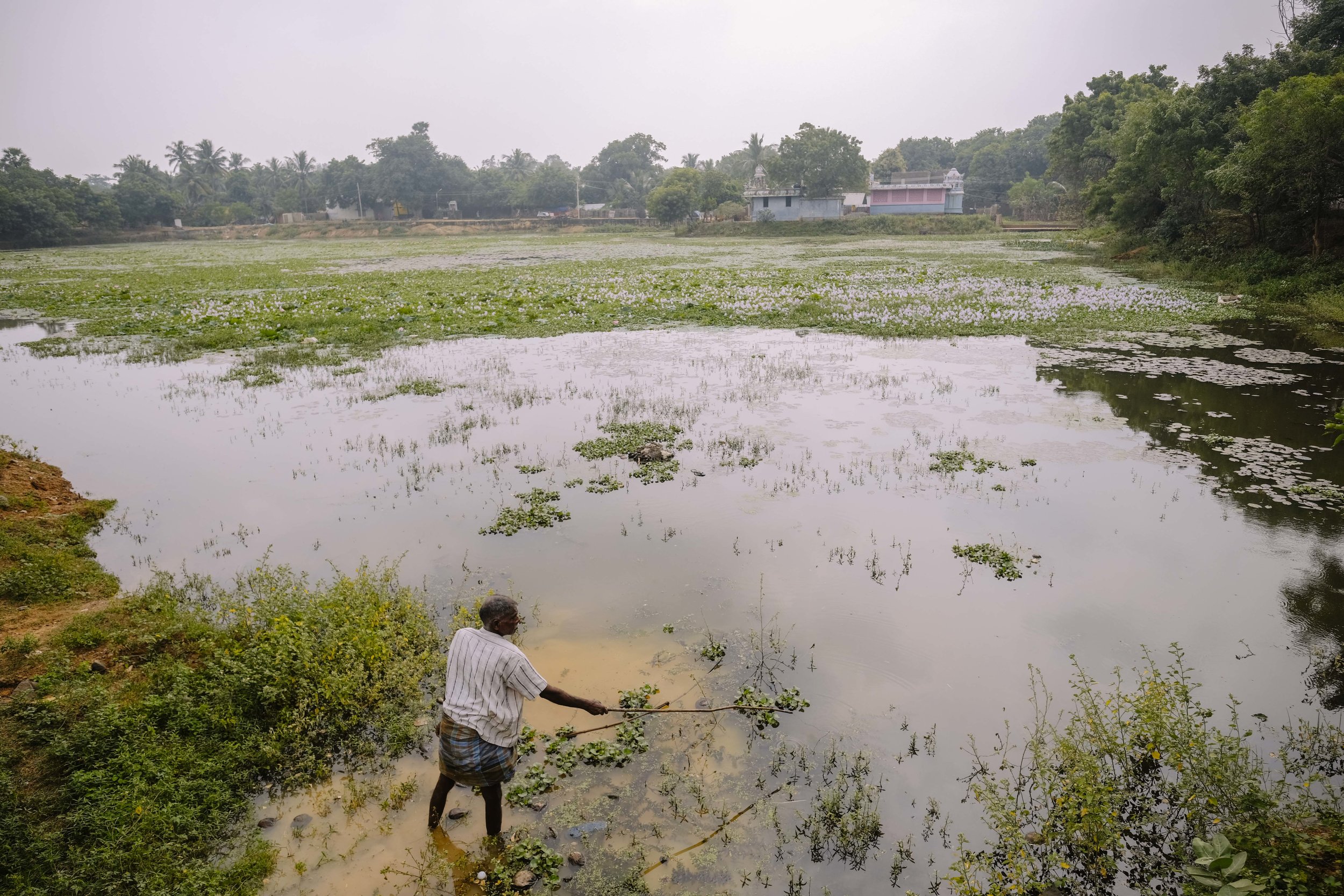NOTES FROM AUROVILLE
by Marc Nair, 07 January 2018
1: The road to Auroville
The view from the descending plane is a mash of colour. Low houses, flanked by unending lines of traffic, are decked in bright, unrelenting primary hues. At the airport, I hang around the terminal exit, promptly getting fleeced for a sim card and securing a taxi for the 3-hour ride to Auroville. I’m also waiting for Alex, who arrives on another flight from Kuala Lumpur. Together with Raghav, who’s traveling overland from Hyderabad, we are headed to Auroville to make a short 360 VR documentary for Vostok VR.
Auroville, known as the City of Dawn, is best described as an experimental township. It was founded in 1968 by Mirra Alfassa (better known as "the Mother") and designed by architect Roger Anger. We’re here to make a 360 documentary travelogue that is planned to be part of a larger series of videos on utopian cities throughout the world. We want to look at the origins of Auroville, the challenges faced over the years and what they have to do today to keep the community alive and thriving.
Volunteers learning how to press bricks at the Earth Institute
At the beginning of the twentieth century the poet Velimir Khlebnikov proposed that all inhabitants of Russia be lodged inside glass cells mounted on wheels, allowing them to travel freely everywhere and to see everything, but without in any way obstructing their visibility to others. In some ways, the smartphone has made that come true.
The goddess Kali can never be lodged in a glass cell, and she will have her due. This is a temple on the outskirts of Auroville.
We live in an age of total tourism. There is no difference between the resident and the traveler. We no longer need to reduce an idea, architectural style or fashion outfit to something pure in essence before it proliferates and is disseminated globally. Globalisation has replaced the future as the site of utopia.
The image of Mirra Alfassa, the Mother, is everywhere in Auroville.
And that is precisely what makes the idea and the reality of Auroville so fascinating. Auroville turns 50 in 2018. Half a century of existence in the most prolific period of growth the world has ever seen. When the Mother founded Auroville, she was laying down a utopian vision to implement her spiritual mentor Sri Aurobindo's vision of new forms of individual and collective life.
A very appropriate random sign by the roadside, reminding us of the completely different direction one has to take when living in Auroville.
On the road, Chennai does not immediately distinguish itself with anything immediately recognisable. It is the usual multitude of people, vehicles, cars and trash. Typical India. Then we get onto the East Coast Road, a coastal toll road that runs for long stretches beside the Great Salt Lake. The 113-km long stretch from Akkarai to Pondicherry passes through some 154 villages.
At points, the road curves between and through thick groves of trees, or spills out into padi. This is fertile India, a verdant allure even as we swerve past auto rickshaws, slide out from behind behemoth trucks and slow down for barricades placed at the entrance to villages. Eventually we turn off into a side road that grows increasingly bumpier and narrower as it makes its way through even more greenness.
I learn later that this is the Fertile Forest, the green belt of Auroville. It is all the more spectacular because when the government first allotted the land to Auroville the place was barren, a literal wasteland. We rattle through and suddenly, we seem to be in Auroville, though all we see are forests, a succession of small roads and a series of signs with very intriguing names like ‘Discipline’, ‘Aspiration’ and ‘Surrender.’
2: Being and Becoming
Most people doing a preliminary search on Auroville are serenaded by a cascade of images of the Matrimandir (more on that later), or activities such as meditation or yoga. But nothing has been written of the vast space, scale and scope of Auroville, how it has become a world unto itself.
The master plan for the layout of Auroville is shaped like a galaxy, in which several lines of force unwind from the centre, the Matrimandir. Radiating beyond are four zones, each focusing on an important aspect of the township’s life: an industrial zone, a cultural zone, a residential zone and an international zone.
Alex making a shot close to the Visitors Centre in Auroville.
On the ground, we quickly realise the impossibility of trying to cover all of Auroville in the four days we are there. But the situation quickly complicates. We need a permit to film in most of the public places in Auroville and we didn’t get one (primarily because the cost was ridiculously prohibitive). Furthermore, the Matrimandir, which featured at the centre of our pre-production discussions, was off-limits to the camera. A snap decision had to be made. So we decided to make a short film instead, with a fictional voiceover about a man who comes to Auroville to find meaning. It was, in many ways, the only logical rescue. Certain communities in Auroville gave us permission to film them, but on the whole this was far from being a tourist destination, so we had to fully respect the wishes of Aurovilians.
3: The Matrimandir
Despite not being able to take our camera into the Matrimandir, we decide to visit it anyway. But it’s not designed to be a tourist experience. You just can’t pay your fee and line up for it. For a start, we first have to watch a compulsory video on the origins of the Matrimandir, then queue for a pass at a fixed time (twice a day for an hour), then show up at the allotted time two days later. Only 76 people are allowed in per session.
We are bussed to a different gate from the viewing point, and are then led to a small garden. The Matrimandir rises like a golden alien orb from behind a grove of trees, startling against a blue sky. ‘Please remain quiet’ a sign remonstrates, but already there is a low murmur (of anticipation, rising wonder?) One woman breaks the no cellphone ban and snaps pictures.
“Auroville is here to realise human unity,” shares our guide. We sit under a large, leafy tree, facing the dome. He asks the group, "What will you do to realise human unity?"
Be kind, get organised, forget social status, eat and share good food, listen, laugh. These are some of the many responses.
“It’s time,” he says. We walk down a ramp between red sandstone petals. Together, they form a lotus. Each petal contains a meditation room. We sit around the lotus pond, under the matrimandir. A small gong sounds and we stand up and enter through one of the many openings. In an antechamber, we put white socks on to protect the marble. We walk up more stairs to a ramp and into the inner chamber. The whole space resonates with light and is so surreal that it wouldn’t be out of place on the set of Blade Runner.
Inside the inner chamber, there are 12 pillars that support the structure. We sit on small cushions, eyes fixated on the centre, where a large crystal seems to hum with a tangible energy. A single beam of light, guided by a heliostat (a computer-controlled mirror), shines down through the roof. It passes through the crystal and down into the lotus pond below. We are supposed to ‘concentrate.’ No chanting or movement is allowed. I must say I am pretty rubbish at concentrating. For some reason a succession of U2 songs entered my head. We remain seated, fixated on the crystal for at least fifteen minutes before the signal is given for all of us to troop out of the chamber.
But starting from that night, a strange thing happened. I could remember my dreams again. I had not being able to do so for the longest time. So was there some kind of energy in that chamber? I certainly think so!
4: Communities
While having rather bland coffee at Ganesh Bakery, we strike up a conversation with Jorge, an older gentleman. We learn he is a farmer and but also builds giant 3-D printers that create small huts in the nearby farm of TerraSoul.
People here hold multiple jobs in diverse fields. His fellow farmer, Juan, is a farmer in the morning and a Thai massage therapist in the afternoon. Jorge, originally from Ecuador, has been here for the last seven years. He took over TerraSoul a few years ago and has shifted its focus. He’s able to do this because nobody owns anything in Auroville, not the land nor the buildings. So if someone wants to leave, they just vacate their property and hand over the keys to someone who shows the willingness to carry on with the work.
Jorge (on the right) sorting vegetables with Juan at TerraSoul.
There are over 100 settlements in Auroville, and they all differ in size, style and standard of living. According to the Auroville website:
The names of many of the different settlements carry psychological significances pertaining to the Integral Yoga practiced in the township, such as Sincerity, Aspiration, Fraternity, Surrender, Adventure and so on. In the late sixties and early seventies of the last century, the Mother allotted names to the then emerging settlements. Later on, residents wishing to cultivate a new plot would take their time to sense the spirit of the land and space of their choice, and name it accordingly.
Jorge leads us around his farm, pausing by a house under construction. It is being made from mud and palm leaves. The foundation is mud and dry grass. He’s in the middle of running a three-day workshop for people to learn how to make primitive, but effective houses. There’s something very satisfying indeed about building your own house.
A house-in-progress






















